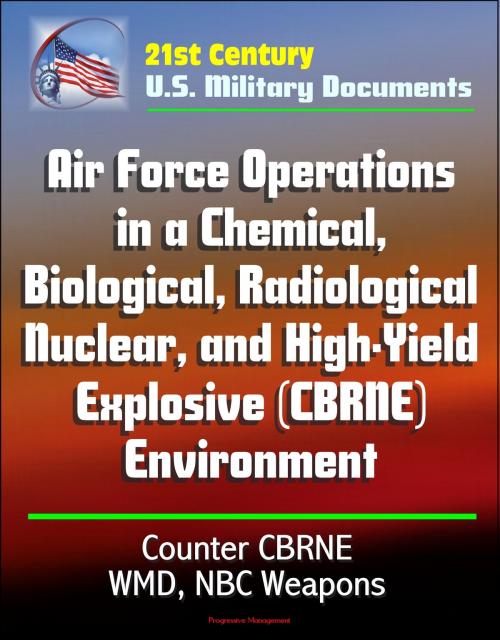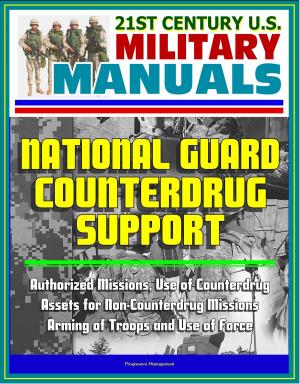21st Century U.S. Military Documents: Air Force Operations in a Chemical, Biological, Radiological, Nuclear, and High-Yield Explosive (CBRNE) Environment, Counter CBRNE, WMD, NBC Weapons
Nonfiction, History, Military, Biological & Chemical Warfare, Nuclear Warfare| Author: | Progressive Management | ISBN: | 9781301438242 |
| Publisher: | Progressive Management | Publication: | October 13, 2013 |
| Imprint: | Smashwords Edition | Language: | English |
| Author: | Progressive Management |
| ISBN: | 9781301438242 |
| Publisher: | Progressive Management |
| Publication: | October 13, 2013 |
| Imprint: | Smashwords Edition |
| Language: | English |
How Air Force installations and units operate in a chemical, biological, radiological, nuclear, and high yield explosive environment is an evolving effort. In 2002 the Air Force implemented the counter-chemical warfare concept of operations (CONOPS) that changed how installations prepared for and responded to conventional chemical munitions attacks. The AF further defined the most probable threat as tactical ballistic missiles. That reevaluation of the threat became the basis for developing tactics, techniques and procedures (TTP) for installations to recover and continue mission operations. In 2003, the AF began investigating potential vulnerabilities for biological attacks by conducting exercises at Kunsan AB, Korea. These exercises led to the development and refinement of TTPs for responding to conventional and irregular biological warfare attacks. The resulting counter-biological warfare CONOPS was institutionalized through two Air Force Instructions: AFI 10-2603, Emergency Health Powers on Air Force Installations and AFI 10-2604, Disease Containment Planning Guidance. In 2009, the Air Force published and began implementing the Counter-Radiological Warfare CONOPS. This CONOPS is being institutionalized through this document and other Air Force and multiservice directives.
The nuclear threat has been exhaustively studied. The AF will review existing information to determine a need to change TTPs for nuclear weapon threats. This manual will incorporate the information from all CBRNE efforts as they mature in order to provide installations guidance to prepare for, respond to, and recover from a conventional or irregular CBRNE attack.
In addition to developing Counter-Chemical, Biological, Radiological CONOPS, the AF has made changes to its emergency response procedures and operations.
Contents: Operations in a Chemical, Biological, Radiological, Nuclear, and High-Yield Explosive (CBRNE) Environment Chapter 1 OVERVIEW * 1.1. Overview * 1.2. Purpose * 1.3. Mission * 1.4. Operational Environment * 1.5. Policy Overview * Chapter 2 * PREPAREDNESS * 2.1. Preparedness Overview * 2.2. Planning - Threat Probability and the Operational Environment * 2.3. Training and Exercises * Chapter 3 * RESPONSE * 3.1. Response Overview * 3.2. CBRNE Operational Standards and Enabling Tasks * 3.3. Trigger Events * 3.4. Response Command and Control * 3.5. Installation Notification and Warning System (INWS) * 3.6. First and Emergency Responders' Missions * 3.7. Conventional CBRNE Attack Response * 3.8. Terrorist Attack Response Actions * 3.9. Withdrawal/Evacuation * Chapter 4 * RECOVERY AND MITIGATION * 4.1. Overview of Recovery and Mitigation * 4.2. Contamination Control * 4.3. Contamination Avoidance * 4.4. Recovery Actions for Conventional and Irregular CBRNE Attacks * 4.5. Hazard Duration * 4.6. Mission Continuation * 4.7. Medical Protection and Casualty Management * 4.8. Restoration of Infrastructure * 4.9. Mitigation * Chapter 5 * INFORMATION COLLECTION, RECORDS, AND FORMS * 5.1. Information Collections * 5.2. Records * Attachment 1 * GLOSSARY OF REFERENCES AND SUPPORTING INFORMATION * Attachment 2 * IPE AND PPE ANALYSIS * Attachment 3 * INCIDENT COMMANDER'S GUIDE TO FIRST AND EMERGENCY RESPONSE MISSIONS * Attachment 4—SHELTER PROCEDURES * Attachment 5—CHEMICAL, BIOLOGICAL, RADIOLOGICAL, NUCLEAR, AND HIGH YIELD EXPLOSIVES RESPONSE DECISION TOOLS * Attachment 6—REPRESENTATIVE CBRNE THREAT PROFILES * Attachment 7—POST ATTACK RECONNAISSANCE (PAR) TEAMS * Attachment 8—CHEMICAL, BIOLOGICAL, RADIOLOGICAL AND NUCLEAR (CBRN) FORCE PROTECTION (FP) MEASURES * Attachment 9—CONTAMINATION CONTROL AREA (CCA) PROCEDURES
Education, Training and Exercise Competencies for Counter-Chemical, Biological, Radiological and Nuclear Operations * Counter-Chemical, Biological, Radiological and Nuclear Operations * Safeguarding Biological Select Agents and Toxins * Bonus: Air Force Culture / Doctrine Instruction / Policy Directive
How Air Force installations and units operate in a chemical, biological, radiological, nuclear, and high yield explosive environment is an evolving effort. In 2002 the Air Force implemented the counter-chemical warfare concept of operations (CONOPS) that changed how installations prepared for and responded to conventional chemical munitions attacks. The AF further defined the most probable threat as tactical ballistic missiles. That reevaluation of the threat became the basis for developing tactics, techniques and procedures (TTP) for installations to recover and continue mission operations. In 2003, the AF began investigating potential vulnerabilities for biological attacks by conducting exercises at Kunsan AB, Korea. These exercises led to the development and refinement of TTPs for responding to conventional and irregular biological warfare attacks. The resulting counter-biological warfare CONOPS was institutionalized through two Air Force Instructions: AFI 10-2603, Emergency Health Powers on Air Force Installations and AFI 10-2604, Disease Containment Planning Guidance. In 2009, the Air Force published and began implementing the Counter-Radiological Warfare CONOPS. This CONOPS is being institutionalized through this document and other Air Force and multiservice directives.
The nuclear threat has been exhaustively studied. The AF will review existing information to determine a need to change TTPs for nuclear weapon threats. This manual will incorporate the information from all CBRNE efforts as they mature in order to provide installations guidance to prepare for, respond to, and recover from a conventional or irregular CBRNE attack.
In addition to developing Counter-Chemical, Biological, Radiological CONOPS, the AF has made changes to its emergency response procedures and operations.
Contents: Operations in a Chemical, Biological, Radiological, Nuclear, and High-Yield Explosive (CBRNE) Environment Chapter 1 OVERVIEW * 1.1. Overview * 1.2. Purpose * 1.3. Mission * 1.4. Operational Environment * 1.5. Policy Overview * Chapter 2 * PREPAREDNESS * 2.1. Preparedness Overview * 2.2. Planning - Threat Probability and the Operational Environment * 2.3. Training and Exercises * Chapter 3 * RESPONSE * 3.1. Response Overview * 3.2. CBRNE Operational Standards and Enabling Tasks * 3.3. Trigger Events * 3.4. Response Command and Control * 3.5. Installation Notification and Warning System (INWS) * 3.6. First and Emergency Responders' Missions * 3.7. Conventional CBRNE Attack Response * 3.8. Terrorist Attack Response Actions * 3.9. Withdrawal/Evacuation * Chapter 4 * RECOVERY AND MITIGATION * 4.1. Overview of Recovery and Mitigation * 4.2. Contamination Control * 4.3. Contamination Avoidance * 4.4. Recovery Actions for Conventional and Irregular CBRNE Attacks * 4.5. Hazard Duration * 4.6. Mission Continuation * 4.7. Medical Protection and Casualty Management * 4.8. Restoration of Infrastructure * 4.9. Mitigation * Chapter 5 * INFORMATION COLLECTION, RECORDS, AND FORMS * 5.1. Information Collections * 5.2. Records * Attachment 1 * GLOSSARY OF REFERENCES AND SUPPORTING INFORMATION * Attachment 2 * IPE AND PPE ANALYSIS * Attachment 3 * INCIDENT COMMANDER'S GUIDE TO FIRST AND EMERGENCY RESPONSE MISSIONS * Attachment 4—SHELTER PROCEDURES * Attachment 5—CHEMICAL, BIOLOGICAL, RADIOLOGICAL, NUCLEAR, AND HIGH YIELD EXPLOSIVES RESPONSE DECISION TOOLS * Attachment 6—REPRESENTATIVE CBRNE THREAT PROFILES * Attachment 7—POST ATTACK RECONNAISSANCE (PAR) TEAMS * Attachment 8—CHEMICAL, BIOLOGICAL, RADIOLOGICAL AND NUCLEAR (CBRN) FORCE PROTECTION (FP) MEASURES * Attachment 9—CONTAMINATION CONTROL AREA (CCA) PROCEDURES
Education, Training and Exercise Competencies for Counter-Chemical, Biological, Radiological and Nuclear Operations * Counter-Chemical, Biological, Radiological and Nuclear Operations * Safeguarding Biological Select Agents and Toxins * Bonus: Air Force Culture / Doctrine Instruction / Policy Directive















